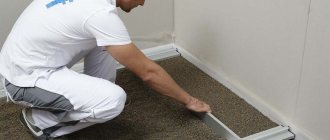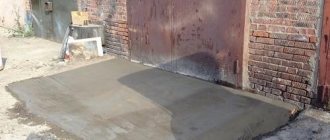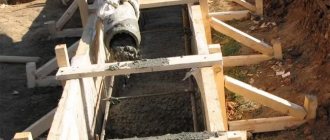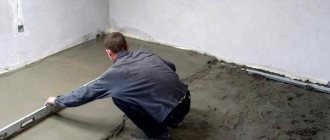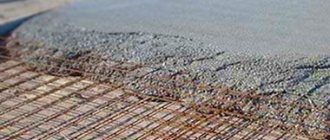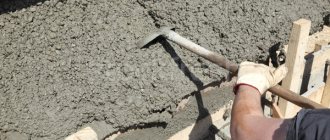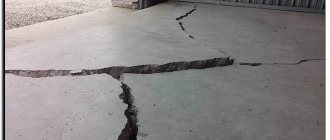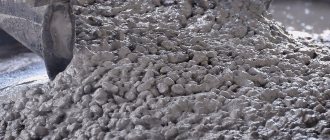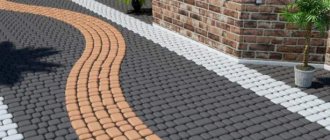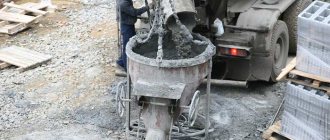by Alexey | Tools Tips Decor Workshop | Friday, March 13, 2020
| Follow Make-Self.net on Facebook and be the first to read our articles. |
While the summer sun encourages outdoor projects, it also poses its own challenges. Today you'll learn how to beat the heat as you pour concrete for garden borders, patio paths and more.
Longer days and warmer temperatures make summer the prime season for tackling home projects inside and outside the home. But these warm, sunny days may or may not be beneficial: All that heat and dryness can pose a few problems for projects that involve pouring concrete.
Fill when it's cooler
Typically, 30 degrees Celsius is the cutoff point . If the temperature exceeds 30 degrees, then plan to reschedule the work to another day. In summer, pour concrete as early in the morning as possible. This is typically the coolest part of the day and therefore provides the best opportunity for moisture retention as the concrete begins to harden. If you can't start in the morning, try doing it in the evening when the temperature starts to drop.
Photography - unsplash
Dependence of solidification rate on temperature
At +5°C, the curing rate of concrete is reduced by 5 times compared to the values achieved at +20°C. In general, the rule here is: the colder the air, the lower the rate of hardening. When the temperature drops below 0°C, this process stops, and frozen water, due to expansion, destroys concrete from the inside without the possibility of recovery. The resulting monolith will no longer reach the design strength; on the contrary, it may crack, deform or crumble.
Before you buy cement with delivery, you should know that pouring concrete mortar is prohibited in the following cases:
- At a temperature outside the window of +5°C or less, if you do not plan to heat the concrete or add frost-resistant additives to the solution.
- In the off-season - due to instability of temperature and air humidity.
- At a temperature of +25°C in combination with an air humidity level of less than 50%, because rapid evaporation of water will not allow the monolith to gain strength.
Block out the sun and wind
Sunlight on wet concrete speeds up the evaporation process, and strong winds can have the same detrimental effect or worse. Windy weather can dry out the surface of the concrete before you can smooth it and finish the edges or create texture (if you're pouring slab) . Place sun shades, wind blocks and anything else you can install to block the sun and wind while concreting, then leave the protection on for a few hours after you've finished.
Photography - unsplash
Strength of concrete structures
After mixing cement with water, the fluidity of the solution is maintained for several hours, but then thickening begins, and the process of hardening and hardening begins.
It takes 20 minutes for concrete to set. up to 20 hours, the speed of the process is determined by the ambient temperature. In frosty weather, when the thermometer drops to 0°C, setting begins 6-10 hours after pouring and continues for 15-20 hours. It will take another 4 weeks for the concrete to gain grade strength. The solution hardens best at +20°C and high air humidity (up to 100%).
Prepare well
Review your project's materials list and make sure everything you need is within reach before you start mixing cement. There's nothing worse than starting to pour concrete and then realizing you forgot your shovel, trowel or level! Once the pouring begins, every minute counts—there's no time to search for any tools or supplies you may have forgotten.
Before you begin, you will also need to make sure that you have enough concrete to complete the task. Too little concrete and you risk not filling the entire form in one go. If you have to fill the rest of the form later, the concrete you poured will have already hardened and will not form a strong bond with the concrete you add, creating a "cold joint" or weak point in the concrete.
How are the peculiarities of the Russian climate related to concreting?
Climatic features have a great influence on construction work.
One of the most common building materials is concrete, as well as cement mortars, that is, materials made on the basis of cement.
The following are made from concrete:
- foundations;
- monolithic walls;
- floors;
- stairs;
- paths, platforms, industrial floors
and much more.
Cement mortars are used for masonry of brick, stone and blocks, as well as for finishing work.
Thus, at many stages of construction, concrete mixtures and cement mortars are used.
But, unfortunately, they are not friendly with low temperatures.
Wet the concrete
If you are pouring a slab, you likely have a gravel soil at the bottom to help support the slab. Wet the gravel with the hose until it is saturated with water, but do not allow puddles to form. Also wet the concrete forms to moisten and cool them. A dry base can quickly suck moisture out of concrete, speeding up the drying process and ultimately weakening it.
Photography - unsplash
Is it possible to pour concrete in the summer when it’s hot?
To judge the consequences, you need to know why concrete does not gain strength in the heat.
The main problem is the quick setting of the mixture. Under normal conditions, water mixes with cement and filler, hydration begins - the concrete gradually gains strength. High temperatures greatly speed up the process.
This creates several problems:
1. Due to the rapid loss of moisture, the surface cracks and loses its integrity. Concrete generates dust, absorbs water and is less resistant to the freeze-thaw cycle.
2. Hardening too quickly, the solution does not gain brand strength. A uniform crystal lattice is formed in approximately 28 days.
To solve the problem, special additives are used. They slow down the setting process and give time for chemical reactions to complete.
Hire Helpers
If you have a large pour, such as a patio or sidewalk, you'll need a lot of strong hands to help mix the concrete, spread it into the forms, level it, and finish the surface. Without enough help, it can be difficult to pour concrete into forms and level it before it begins to harden. To work quickly and efficiently on project day, make sure all your assistants know what they will be doing before they begin.
Photography - unsplash
Components of concrete mixtures and their purpose
Most often, various grades of concrete are used during construction work. Each component included in such a mixture has its own purpose:
- crushed stone forms a coarse-grained frame. It increases the strength characteristics of concrete and prevents the appearance of cracks during its hardening;
- sand is a fine aggregate. It occupies the voids between the grains of crushed stone, forms a fine-grained frame and also protects the concrete from the formation of cracks;
- cement is necessary to bind the aggregates. It takes part in the hydration process, resulting in the formation of cement stone. This phenomenon is accompanied by the release of heat;
- water allows all existing components of the mixture to be evenly distributed throughout its volume. It, along with cement, is necessary for the formation of cement stone.
Concrete is an invariable companion of any construction.
Concrete is considered the most common building mixture on our planet. Approximately 6 billion cubic meters of product are produced every year. This figure is comparable to the world's population. In fact, for each of its inhabitants there is one cubic meter of concrete produced.
Use cold water
Whether you mix the concrete by hand or use a concrete mixer, make sure the water is cold and always follow the directions on the back of the cement bag.
Photography - unsplash
For better temperature control, use water directly from the garden hose and let it run for a few seconds each time you turn it on until the water is cold. If you are pouring concrete in an area where the hose cannot reach, fill the cooler with a bag of ice and add it to the bucket of water as needed to keep the water cold.
Winter care
All construction and repair work that involves the use of concrete mixture is not recommended to be carried out in cold weather, i.e. in winter. Construction in the cold season will require additional financial costs.
If the air temperature drops below 0°C for a short period of time and then rises above +5°C, frost is not critical. In order for the structure to harden properly, special anti-frost modifiers are added to the solution. They prevent the mixture from freezing. If they are not used, it is recommended to heat the solution before pouring and wrap it.
At large construction sites, special heaters can be used in winter. At home, their use will be expensive. Caring for concrete in winter means keeping it warm. Heating is necessary in order to retain the thermal energy of hydration in the solution.
Slow down the curing process
If you followed the tips above, the pouring itself should go smoothly! But don't relax. You will still need to take steps to prevent the moisture from evaporating too quickly. The slower a new concrete project dries, the stronger it will be.
Photography - unsplash
After smoothing and sanding the concrete surface, wet the concrete surface using a spray hose and repeat this process as necessary to keep the concrete surface damp. For the next seven days, you should continue to wet the concrete several times a day, but the first few days are the most important.
Follow us on Pinterest for more interesting articles.
Useful short videos from Make-Self.net
Rules of care
In order for the structure to meet all requirements, it is necessary to properly prepare the concrete mixture. It is not recommended to store building material for a long time even in a special mixer. The mixture should be used immediately after mixing.
The average daily air temperature at which the solution will harden well should not be lower than +5°C.
To prevent the concrete structure from being washed away by groundwater (if the product is made on the ground, such as a foundation), waterproofing should be installed. Otherwise, the hardening process may be disrupted.
Concrete care begins immediately after pouring. It is necessary to inspect the structure for leaks, unevenness and other defects that may cause a deformed product.
The material must gradually increase its strength. For this process to proceed correctly, it is necessary to create optimal humidity and thermal conditions. After pouring, it is recommended to cover the mixture with plastic wrap. It will prevent the solution from drying out prematurely. If the structure quickly loses moisture, for example, after 60-90 minutes, the formwork should be checked for integrity.
The plastic film will allow the concrete mixture to harden evenly. If you do not use it, the top layer of the structure will dry out faster and will put pressure on the fragile base.
To prevent cracks from forming on the surface, which will deepen over time, the concrete should be moistened. 8-10 hours after pouring, you need to water the foundation. You can use tap water and a hose to do this.
To water steeply sloped surfaces or vertical structures, use a pipe system with small holes. Through them, continuous irrigation of the product must be carried out. Another way is to cover the concrete with sawdust or burlap. If these materials are wet, they will retain moisture for a long time and reduce the percentage of evaporation.
When the outside temperature drops below +5°C, the concrete structure cannot be wetted. It is covered with plastic film, and additionally covered with heat-insulating material, for example, mineral wool.
Concrete reaches its maximum strength after a month, but its physical properties are influenced by the first 3 days. It is recommended to start stripping no earlier than after 3-4 days. There are differences between how to care for concrete in summer and winter.
Freeze protection methods
If the foundation must inevitably be poured in the fall, be sure to use one of the following methods to prevent the mortar from freezing while curing:
- The use of anti-frost additives allowing concrete to achieve the required strength at temperatures down to -20 ° C. The negative point is a significant increase in the cost of construction, which does not allow using the technique for arranging large foundations.
- The use of electrical heating of concrete with a special heat cable laid over the surface and covered with insulation. The method of passing voltage with high current is effective, but expensive, given the high cost of energy.
- Covering the base with sheets of polystyrene foam, tyrsa, mineral wool, film or any heat-insulating materials. An inexpensive, justified method of protection that allows the slowly cooling composition to retain heat throughout the week and provide a comfortable setting.
- Installation of thermal formwork. Carried out by specialized construction companies. This is an expensive but effective method that allows you to increase the temperature of the massif to + 30 ° C and maintain it throughout the setting period.
Of course, it is best to complete the work before the onset of cold weather. If you build in September, then laying the foundation will not lead to additional costs. The closer to winter, the greater the likelihood of problematic situations.
An advantage for laying a foundation in the fall compared to summer is the groundwater level, which is often significantly lower than in the summer
Special antifreeze additives for the solution
To increase frost resistance, special chemical components are used. They make it possible to carry out work down to a temperature of -25°C.
Additives – increase hydration in frost conditions. They accelerate setting and hardening in combination with additional heating of concrete.
Antifreezes are compounds that increase the adhesion properties of a solution under any operating conditions. Additives are divided according to the main active ingredient included in the composition:
- Sodium formate. Increases the accumulation of salts in the monolith, used only in conjunction with plasticizers.
- Sodium chloride. Provokes corrosion of reinforcement and prevents rapid thickening of the solution. Suitable for Portland cement based mixtures.
- Sodium nitrite. Not used for alumina mixtures. Working with the solution becomes possible down to -15°C.
- Calcium carbonate (potash). Increases the operating temperature range to -30°.
Plasticizers - increase the density of the mixture, reducing the cost of cement and water. The working time for concrete with these additives is much longer, which allows you to take your time when laying.
Hardening accelerator - reduces working time, increases the strength of finished monoliths, but reduces the plasticity of concrete.
Complex additives - combine several ways to improve frost-resistant qualities.
The nuances of using additives:
- The operating conditions of the concrete structure are taken into account. For example, if the monolith will be exposed to intense gas, the concrete solution should not contain additives obtained from the reaction of calcium and hydrochloric acid.
- It is not recommended to mix additives on your own to improve various properties of the solution. The chemical elements included in the composition can negatively interact with each other. It is better to use ready-made complex additives.
- The presence of outlet and insert elements implies the use of antifreeze. It is added to the solution at the mixing stage.
How many days to water concrete after pouring?
Watering should be continued until the lower layers of the foundation are completely hardened.
Experienced builders do this intuitively, but novice craftsmen are better off sticking to certain parameters. The hardening time is most influenced by:
The direct speed of cement hardening also affects:
The timing of maintenance of the structure is influenced by the time of year and, accordingly, the temperature:
In general, watering must be done until the structure reaches 70% strength. Usually this takes 10 days, but depending on weather conditions, the period may decrease or increase. Watering should not be carried out beyond the established period, since excessive moisture can, on the contrary, slow down the rate of hardening.
Source
Caring for concrete during low temperatures
First of all, it is necessary to mention that it is better to work with concrete in the warm season, since the temperature regime is the most important factor in the monolith gaining strength during hardening.
Important! If the solution is prepared independently, then hot water must be used for mixing. The finished mixture is poured continuously, stopping is strictly prohibited. If, after all, the surface of the concrete is frozen, then open steam must be supplied to it and the frozen crust must be removed. Filling resumes immediately.
Winter concreting involves various technological measures:
- The use of mixtures to which antifreeze and antifreeze components are added by the manufacturer.
- Deepening electrodes on cables from powerful transformer installations into the mixture for heating.
- At borderline temperatures from -5 to +5 degrees Celsius, the monolith is covered with thermal film.
- The ebb tide can be covered with a tent structure, inside of which a heat gun or steam heater is placed.
- Use of infrared heating for thin facing concrete surfaces. Using more powerful devices will lead to overheating and destruction of the structure.
Important! When applying steam to the top edge, the temperature must be controlled. The steam must be dry. The check mode is 4 times in the first 8 hours, 2 times in the next 8 hours, and after that the temperature is checked once a day. If infrared heaters are used, they are removed from the formwork at a distance of at least 1.5 meters. For better exposure of the infrared spectrum to the heating surface, it is painted with black emulsion paint.
If concreting is carried out at -15-20 degrees Celsius, then it is necessary to purchase special thermal formwork. It consists of prefabricated boxes made of plates, each of which is equipped with an electric heating element. The formwork is used for the first 48 hours, after which it is dismantled, and the hardening artificial stone is covered with a tent structure with constant heating.
Do I need to water the foundation after pouring it and how often should I do it?
The foundation is the foundation of the house, which bears all the loads from the structures located above. If he can't stand them, the house will fall apart. Therefore, its strength must be taken care of at all stages: from design to pouring and the end of concrete hardening. And if everyone agrees with the first two points, then most developers, immediately after installing the foundation, consider the job done and simply wait for it to set in order to continue construction. And when asked whether it is necessary to water the foundation after pouring, they shrug their shoulders in bewilderment - why... This is exactly what we will consider in the article.
Freshly poured concrete foundation
The influence of negative temperature on concrete hardening
At temperatures above +5°C, cement hydration occurs normally. If the temperature suddenly drops below 0°C, the water in the mixture will freeze and the process will freeze. In this case, the crystals that began to form in the warm mixture will remain in the solution. Winter concrete hardens much longer. If additives are not added to it and it is not heated, the monolith will be heterogeneous, with cracks.
If, after freezing, the solution is heated and the water is melted, then new bonds will form incorrectly and the monolith will not receive the necessary strength.
Ways to solve the problem
The current situation is not hopeless. Otherwise, it would be impossible to carry out construction work in areas with a hot and dry climate. To obtain a mobile concrete mixture, the proportion of water in it increases by 5–10%. As a result, the water-cement ratio increases, but this leads to a decrease in the strength of concrete. To maintain its properties and mobility, cement consumption also needs to be increased by 5–10%.
A similar result can be achieved without increasing the proportion of water and cement in concrete. To do this, you need to lower the temperature of the mixture to 10–15 °C. For this purpose, you can add some water to the solution in the form of ice. Another way is to use plasticizing, surfactant or plasticizing-air-entraining additives.
